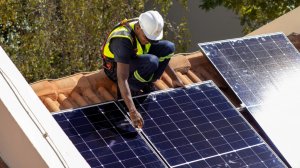Solar rental firm begins testing roll-out model for underserved communities
Local solar-as-a-subscription service provider Wetility is deploying a rooftop solar solution in a lower-income community as part of a proof-of-concept study to firm up the feasibility of extending the offering to other underserved areas.
COO Franta Pour tells Engineering News that the company’s current focus is on the provision of bundled solar-battery rental solutions to more affluent households and small and medium-sized businesses, where attention is shifting progressively from security of supply to electricity bill savings.
Despite being loadshedding-sensitive, he expects this higher-income market to continue to grow, but for customers to increasingly opt for solutions that extend well beyond panels and batteries to include ways of optimising production and accelerating their returns on investment, including through the integration of smart-geyser control systems.
“We anticipate that the market has started to rapidly progress beyond loadshedding to emphasise savings, customer experience and maintenance and that it will eventually also be motivated by the goal of reducing environmental impact,” Pour says.
However, 70% of South Africa’s potential household market is located in lower-income areas, where the penetration of solar remains extremely low and where market-ready affordable solutions have not been developed.
Wetility is, thus, working on what it describes as a “fit-for-purpose subscription model” that it believes can help overcome both the key affordability hurdle, as well as the practical difficulties associated with installing solar on properties where ownership is unclear or where illegal connections are common.
“We are currently rolling out systems with a partner who has a strong footprint in lower-income communities.
“We will start sharing the results of the proof-of-concept in the next couple of weeks,” Pour tells Engineering News, without disclosing the location of the pilot or the identity of the company’s partner.
“We are using various strategies to bring power to these households, including community advocacy, specialised credit products to enhance adoption while minimising credit losses, and collectivised schemes such as powering critical community points like schools and clinics.
“This allows multiple households to connect to a larger shared plant and distribute the costs.”
However, he acknowledges that mass deployments will require collaboration with government at various levels, as well as funders, hardware and software providers and, crucially, the communities themselves.
“We believe the discussions should start with local businesses as they provide the backbone of support.
“Once they are convinced and start using solar systems, we can take huge strides forward towards including the residents and, finally, engage local government.”
Wetility is convinced that the benefits of finding a solution will be significant, with cheaper access to reliable and renewable electricity not only ensuring greater lifestyle convenience, but also creating the potential for enterprise development and job creation.
“There are many benefits - the most important one is that competition from private companies will benefit customers and municipalities.
“There will be more innovation, and the diversification of the power sector will help municipalities deliver better services.
“In my opinion, communities will also make a point to protect those assets,” Pour concludes.
Article Enquiry
Email Article
Save Article
Feedback
To advertise email advertising@creamermedia.co.za or click here
Comments
Press Office
Announcements
What's On
Subscribe to improve your user experience...
Option 1 (equivalent of R125 a month):
Receive a weekly copy of Creamer Media's Engineering News & Mining Weekly magazine
(print copy for those in South Africa and e-magazine for those outside of South Africa)
Receive daily email newsletters
Access to full search results
Access archive of magazine back copies
Access to Projects in Progress
Access to ONE Research Report of your choice in PDF format
Option 2 (equivalent of R375 a month):
All benefits from Option 1
PLUS
Access to Creamer Media's Research Channel Africa for ALL Research Reports, in PDF format, on various industrial and mining sectors
including Electricity; Water; Energy Transition; Hydrogen; Roads, Rail and Ports; Coal; Gold; Platinum; Battery Metals; etc.
Already a subscriber?
Forgotten your password?
Receive weekly copy of Creamer Media's Engineering News & Mining Weekly magazine (print copy for those in South Africa and e-magazine for those outside of South Africa)
➕
Recieve daily email newsletters
➕
Access to full search results
➕
Access archive of magazine back copies
➕
Access to Projects in Progress
➕
Access to ONE Research Report of your choice in PDF format
RESEARCH CHANNEL AFRICA
R4500 (equivalent of R375 a month)
SUBSCRIBEAll benefits from Option 1
➕
Access to Creamer Media's Research Channel Africa for ALL Research Reports on various industrial and mining sectors, in PDF format, including on:
Electricity
➕
Water
➕
Energy Transition
➕
Hydrogen
➕
Roads, Rail and Ports
➕
Coal
➕
Gold
➕
Platinum
➕
Battery Metals
➕
etc.
Receive all benefits from Option 1 or Option 2 delivered to numerous people at your company
➕
Multiple User names and Passwords for simultaneous log-ins
➕
Intranet integration access to all in your organisation























